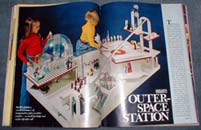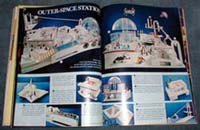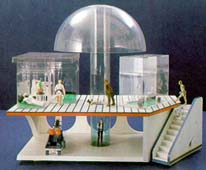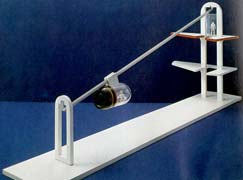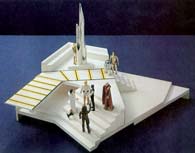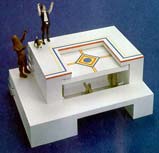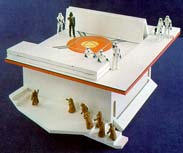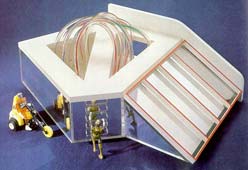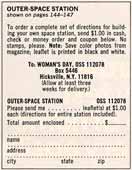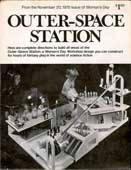

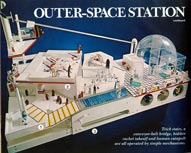 Although Kenner provided kids of the vintage Star Wars era with plenty of playsets with which they could broaden the scope of their
action figure adventures, it's difficult to look back on many of these toys and call them good: With the exception of the
Death Star, all of the playsets issued by the company in the States were small,
boring or of extremely shoddy manufacture. Letís face it, the rather optimistically named
Land of the Jawas may have been a "set" of sorts, but there was precious little "play" to be found amongst its molded plastic dunes and
two-times-used-and-it's-broken elevator. I'm not trying to reveal these toys as somehow unfun--as a kid, I would have played with nearly
anything Kenner released, provided it came in a box that told me it was a Star Wars toy. It's just that I see very little
imagination in most of the Star Wars playsets that were released during the vintage years.
Although Kenner provided kids of the vintage Star Wars era with plenty of playsets with which they could broaden the scope of their
action figure adventures, it's difficult to look back on many of these toys and call them good: With the exception of the
Death Star, all of the playsets issued by the company in the States were small,
boring or of extremely shoddy manufacture. Letís face it, the rather optimistically named
Land of the Jawas may have been a "set" of sorts, but there was precious little "play" to be found amongst its molded plastic dunes and
two-times-used-and-it's-broken elevator. I'm not trying to reveal these toys as somehow unfun--as a kid, I would have played with nearly
anything Kenner released, provided it came in a box that told me it was a Star Wars toy. It's just that I see very little
imagination in most of the Star Wars playsets that were released during the vintage years.
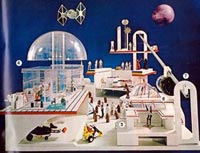 But I digress--this article isn't about Kenner toys. I merely bring them up in order to contrast them with an alternative to, or perhaps it's better termed an outgrowth of, the Star Wars playset theme. The item I write of is an "Outer-Space Station," created by the folks at Woman's Day, and featured in the pages of that magazine as a creative project that parents could build for their children. While the playset bore no definite connection to the Star Wars universe--and, in fact, it was not endorsed by Lucasfilm--the photos of it that appeared in Woman's Day were riddled with Kenner Star Wars figures, presumably so that readers would gain a feeling for how the toy could be used.
But I digress--this article isn't about Kenner toys. I merely bring them up in order to contrast them with an alternative to, or perhaps it's better termed an outgrowth of, the Star Wars playset theme. The item I write of is an "Outer-Space Station," created by the folks at Woman's Day, and featured in the pages of that magazine as a creative project that parents could build for their children. While the playset bore no definite connection to the Star Wars universe--and, in fact, it was not endorsed by Lucasfilm--the photos of it that appeared in Woman's Day were riddled with Kenner Star Wars figures, presumably so that readers would gain a feeling for how the toy could be used.

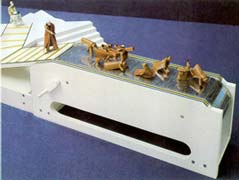 Since the article was published in 1978, the Star Wars figures that appeared in it were all drawn from the debut series of twelve that Kenner issued in that year. In fact, eleven of the twelve original figures were shown in the article's photos, the only exception being the Tusken Raider or Sandperson. However, the Sandperson's desert counterpart, the Jawa, was featured quite prominently: No less than nine of the small brown figures were shown in the photos, usually in a rather humorous light, tumbling goofily or encroaching comically on the territory of the less mysterious-looking figures. But, to todayís collector, the Jawas are interesting for another reason. Namely, they are all of the rare vinyl-cape variety. As most collectors know, the vinyl- or plastic-cape Jawa was available only briefly at retail before being replaced by the much more common cloth-cape type. Since genuine examples of the earlier figure can sell for up to $300 on today's collectibles market, it can rightly be said that upwards of $2500 worth of Jawa figures were photographed by Woman's Day for this feature! (Of course, Woman's Day probably paid $3 each for them, but that's kind of what makes it so funny.)
Since the article was published in 1978, the Star Wars figures that appeared in it were all drawn from the debut series of twelve that Kenner issued in that year. In fact, eleven of the twelve original figures were shown in the article's photos, the only exception being the Tusken Raider or Sandperson. However, the Sandperson's desert counterpart, the Jawa, was featured quite prominently: No less than nine of the small brown figures were shown in the photos, usually in a rather humorous light, tumbling goofily or encroaching comically on the territory of the less mysterious-looking figures. But, to todayís collector, the Jawas are interesting for another reason. Namely, they are all of the rare vinyl-cape variety. As most collectors know, the vinyl- or plastic-cape Jawa was available only briefly at retail before being replaced by the much more common cloth-cape type. Since genuine examples of the earlier figure can sell for up to $300 on today's collectibles market, it can rightly be said that upwards of $2500 worth of Jawa figures were photographed by Woman's Day for this feature! (Of course, Woman's Day probably paid $3 each for them, but that's kind of what makes it so funny.)
 Also appearing in the article were Kenner X-Wing and TIE Fighter toys, as well as several of the Mego companyís Micronauts, a metal-and-plastic line of figures that was part of the fad for sci-fi toys kick-started by Star Wars. All in all, the photos that Woman's Day published presented their custom-made playset as a fun, colorful environment, which could be utilized as a play area for a wide array of action figure toys. I'm sure kids who stumbled across this article while browsing through their mothers' magazines were incited to copious drooling as they imagined their toys inhabiting such a large and complex world. Whether or not they realized that the "planet" that Woman's Day showed hovering above the playset was actually a purple bowling ball is another issue entirely.
Also appearing in the article were Kenner X-Wing and TIE Fighter toys, as well as several of the Mego companyís Micronauts, a metal-and-plastic line of figures that was part of the fad for sci-fi toys kick-started by Star Wars. All in all, the photos that Woman's Day published presented their custom-made playset as a fun, colorful environment, which could be utilized as a play area for a wide array of action figure toys. I'm sure kids who stumbled across this article while browsing through their mothers' magazines were incited to copious drooling as they imagined their toys inhabiting such a large and complex world. Whether or not they realized that the "planet" that Woman's Day showed hovering above the playset was actually a purple bowling ball is another issue entirely.
